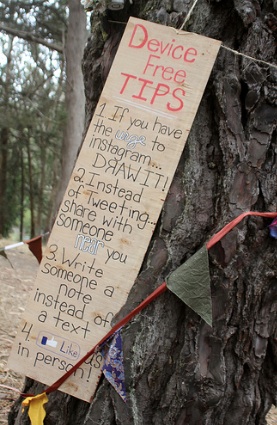Maureen O’Connor at New York Magazine calls it “the Band-Aid of Luddism.” Not that anybody who takes days off from digital media is a Luddite. Certainly not. It’s just that band-aids don’t fix problems; they make them less visible (yes, and help keep things clean, but stay with me for a minute, here).

“We have a tendency to blame technology-mediated problems on the technology itself,” O’Connor thoughtfully writes, “as though Pinterest created homemaker insecurity or Instagram created FOMO [“fear of missing out”]. And though technology can exacerbate any number of woes — maybe you hate your needy boyfriend because he texts too much — few crises occur exclusively online. And so, when someone announces ‘I need to unplug,’ very often what they really mean is, ‘I need to escape a part of my life or psyche that is most visible to me when I see it online.’ Self-hate gets projected onto the screen; turn the screen off and the feeling goes away, right?” Probably not, unfortunately.
So what about “FOMO”? Just as switching off doesn’t really fix what’s bothering us in Snapchat, Twitter or Instagram, staying tuned in all the time, due to “Fear of Missing Out” on what everybody’s saying about everything, doesn’t either. For our own and our children’s sakes, we need to get past fearing or vilifying technology that’s here to stay and go a teeny bit deeper.
We need to talk with our kids about FOMO more than we need to get them some time away from devices. It’s far from just a kid thing, but awareness of what it is and how it can trip us up will go much farther in keeping our kids safe and preparing them for life in a digital age than making them switch off their devices. This is a real, very prevalent “online safety” issue (the social-emotional kind) that will help them all their lives. So for the sake of healthy discussion for growing everybody’s digital, media and social literacy, I offer four kinds of FOMO (you and your kids may think of more and, if you do, by all means share them below in comments!):
Types of FOMO
- The self-defense kind: This might be called “the real FOMO” because the fear can be very real. It’s about needing to know everything being said about “everybody” in case something’s being said about oneself.
- The power-trip kind: part of being a drama queen or king who grows his or her power (or thinks s/he does) by stirring up drama and getting people worked up (and thus vulnerable).
- The busy-body kind: being up on the latest “news” (aka gossip) in one’s peer group or school or workplace just to know everybody’s business. It’s the foundation of…
- The social-capital kind: This is more “transactional” than power-grabbing via drama or social cruelty. It’s just knowing what’s going on to build up, spend and share social capital, but it can still get gossipy and fuel pettiness or worse.

Can you see that none of this arrived on the planet with the birth of digital media? It probably arrived with the birth of humanity, or at least politics. But digital media can certainly distribute and amplify the effects. Some people think of FOMO as a digital addiction. Interestingly, 18-year-old Eoin Corbett in Ireland conducted a very smart one-month experiment about his own use of social media (and a one-week one with three friends), calling it “Internet Addiction and Me” (see this). He found that, after a month away from the everyday “newsy” part of his and his peers’ social media use, he didn’t miss it a bit. He hadn’t in fact been “addicted,” which was probably liberating for him to find out.
Age-old antidotes
Besides awareness of the problem, what helps inoculate kids against FOMO and other social anxieties is a collection of protective “tools” as old as the problem itself:
- Resilience (which grows with social experience and exposure to some social adversity; more here)
- Self-awareness (also called self-knowledge, which aids resilience development)
- Empathy (including compassion for oneself)
- Social skills (the skills gained from social-emotional learning which are described here)
Those things fuel that inner guidance system that dissolves fear of missing out because guidance and confidence need to be crowd-sourced less and less.
As for switching off: How can it help? It can support the process of figuring stuff out by temporarily taking us out of the social media fishbowl when we screw up or just need some space (see O’Connor’s piece for some good examples). Growing up, exploring identity, getting one’s social bearings, making mistakes, learning lessons, etc. “out loud” – very publicly – isn’t easy, but it’s also the new more transparent way of life our children need to learn to navigate. Barring them from it for long periods of time or altogether doesn’t help them. It only delays the learning, and it can cause some social marginalization, which gives them more to work through.
The takeaway our kids really need
Digital downtime isn’t the solution, but it can help. Lena Dunham, the creator of the HBO series Girls called it “controlling your own narrative” in an interview on NPR. Complete control of your story is probably a delusion, in life as well as social media, but taking yourself out of the fishbowl for a bit can certainly give you more control than if you’re working a problem out totally publicly.
However, the ultimate message for our children is not that they need to get away from technology or media. What we really need to help them see is that they are not what “everybody” says or sees about them in life or in social media. Sometimes that means getting some space – in life as much as in media – to think things through, get some emotional distance from uninformed snap judgments, choose the helpers who can really help, set their own pace (not the crowd’s) for learning and find the “signal” amid the noise so they can figure out which is which.
Related links
- For specific examples of social stresses teens experience in and with digital media, see this study from the Harvard School of Education, with this noteworthy statement in the conclusion: “Our findings are not intended to catalyze restrictions that detract from opportunities for connection, nor to enable approaches that dis-empower young people from developing the capacity to make important personal choices.”
- A study of abuse of teens in social media published in the journal Children and Youth Services Review found that the data “failed to corroborate the claim that having social networking site memberships is a strong predictor of online abuse of teenagers. Instead this study finds that demographic and behavioral characteristics of teenagers are stronger predictors of online abuse.”
- “Beautiful Brains,” by author David Dobbs, in National Geographic in 2012: “Why do teenagers act the way they do? Viewed through the eyes of evolution, their most exasperating traits may be the key to success as adults.”
- “What are we really seeing in the social media fishbowl?”
- “All kids deserve the safety & other benefits of social-emotional learning”
- “Balancing external with internal Internet safety tools”

Leave a Reply